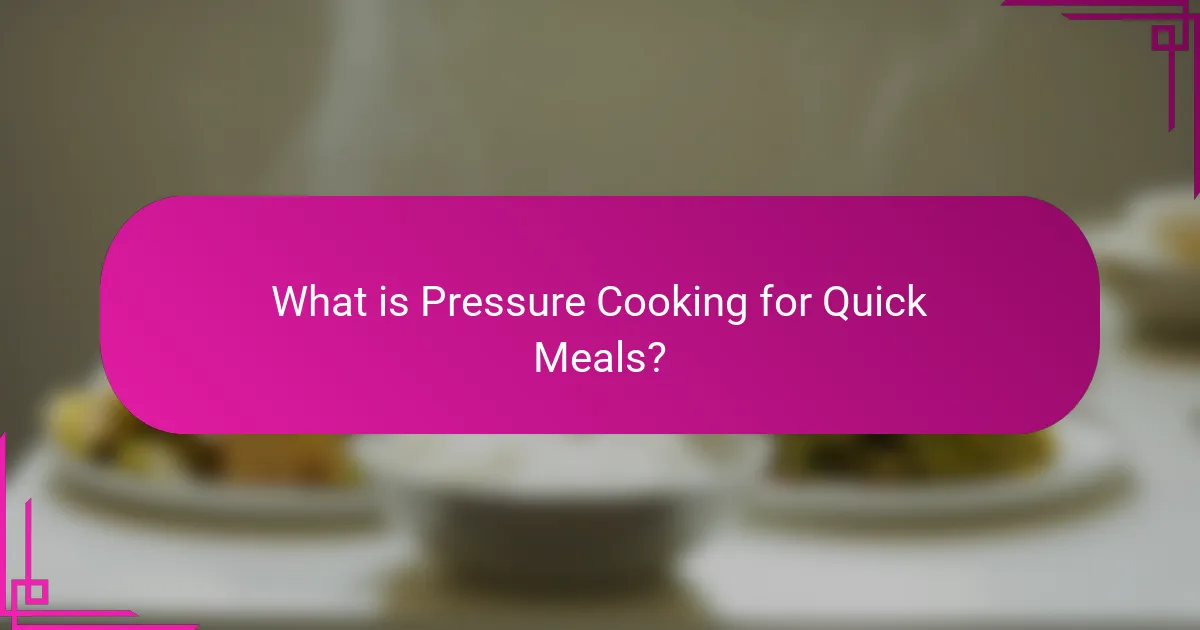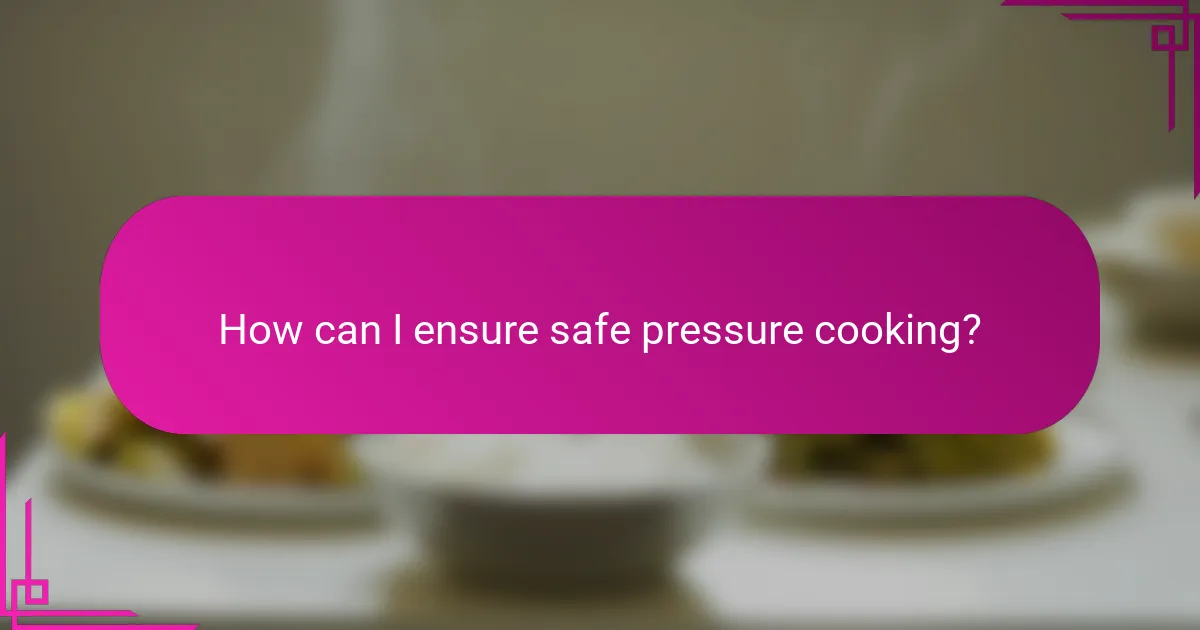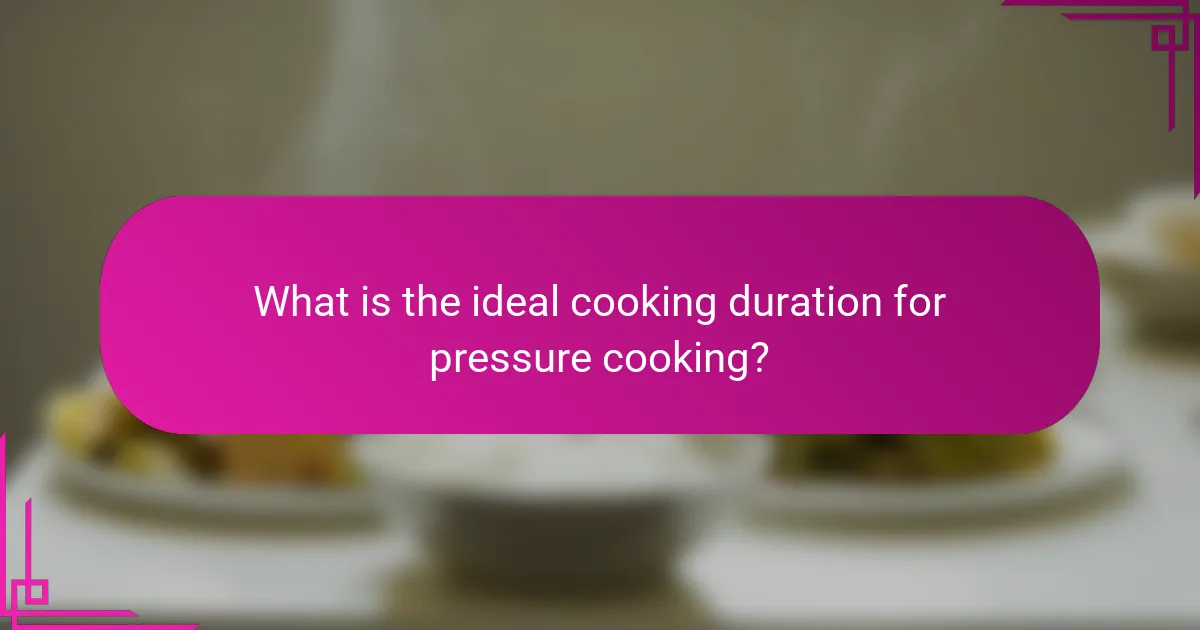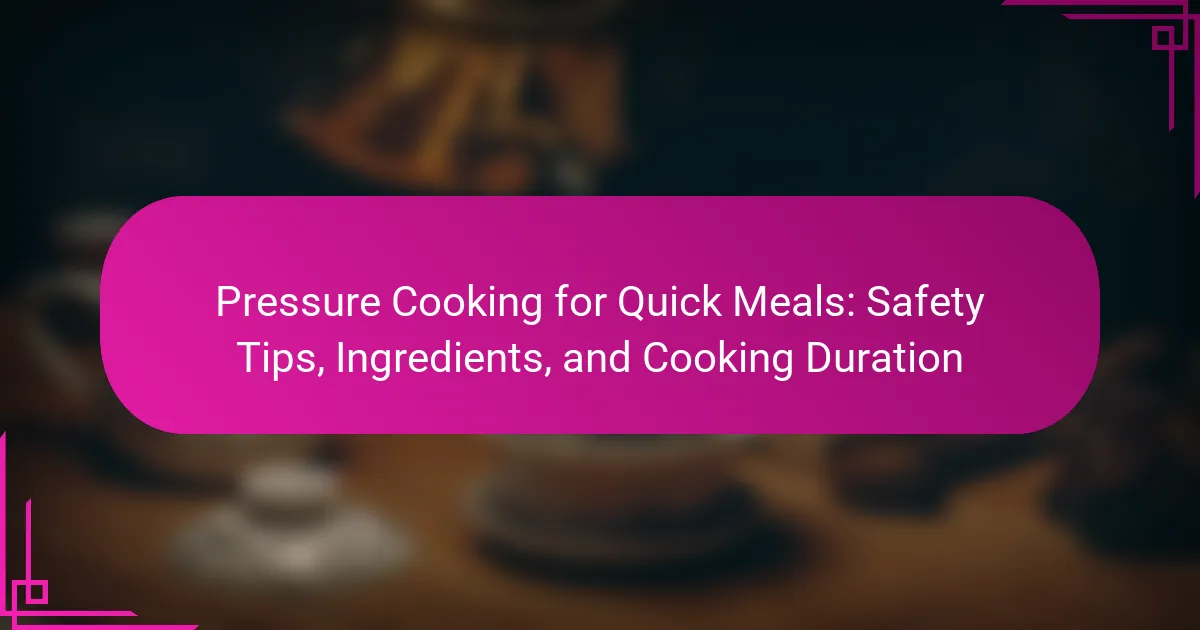Pressure cooking is a fast cooking technique that utilizes steam and high pressure to prepare food quickly while preserving nutrients and flavors. This method can significantly reduce cooking times, allowing items like beans to cook in under 30 minutes compared to traditional methods. The article covers essential safety tips for using pressure cookers, including proper maintenance and operation guidelines. It also provides specific cooking durations for various food types, such as meats, vegetables, legumes, and rice, ensuring optimal results. Understanding these key aspects enhances the pressure cooking experience and promotes safe practices in the kitchen.

What is Pressure Cooking for Quick Meals?
Pressure cooking is a method of cooking food quickly using steam and high pressure. It involves sealing food and liquid in a pot that locks in steam. This process raises the boiling point of water, allowing food to cook faster than traditional methods. Pressure cooking can reduce cooking time by up to 70%. For example, beans that typically take hours can be cooked in under 30 minutes. This method also preserves nutrients and flavors effectively. Pressure cookers are available in stovetop and electric models. Both types are designed for safety with locking mechanisms and pressure release features.
How does pressure cooking work to prepare meals quickly?
Pressure cooking works by creating a sealed environment that raises the boiling point of water. This allows food to cook at higher temperatures than traditional methods. The pressure increases inside the cooker as steam builds up. This results in faster cooking times, often reducing them by up to 70%. For example, beans that typically take hours can be cooked in under 30 minutes. The high pressure also helps to tenderize tougher cuts of meat. Additionally, the sealed environment preserves moisture and nutrients in the food. Therefore, pressure cooking is both efficient and enhances the quality of the meals prepared.
What are the key components of a pressure cooker?
The key components of a pressure cooker include the pot, lid, sealing ring, pressure regulator, and safety valves. The pot is the main body where food is cooked. The lid securely closes the pot to trap steam. The sealing ring creates an airtight seal between the pot and lid. The pressure regulator controls the internal pressure by releasing excess steam. Safety valves prevent overpressure by releasing steam if needed. These components work together to cook food quickly by increasing temperature and pressure, which reduces cooking time significantly.
How does pressure affect cooking time and food texture?
Pressure reduces cooking time significantly. This is due to the increased temperature that pressure creates. At higher pressure, water boils at a higher temperature. For example, water boils at 121 degrees Celsius (250 degrees Fahrenheit) in a pressure cooker. This higher temperature cooks food faster than conventional boiling. Additionally, pressure cooking can alter food texture. Foods often become more tender due to the moist environment. The steam penetrates food quickly, breaking down fibers. This results in softer textures, especially for meats and legumes. Studies show that pressure cooking retains more nutrients compared to other cooking methods.
What are the safety tips for pressure cooking?
Ensure the pressure cooker is properly sealed before use. Check the gasket for wear and tear regularly. Always fill the cooker with the recommended amount of liquid. Overfilling can cause food to block the steam release. Use the pressure release valve carefully to avoid burns. Allow the pressure to drop naturally when possible. Avoid quick-release methods for foods that expand, like grains. Keep the cooker clean to prevent malfunctions. Follow the manufacturer’s instructions for your specific model. These practices enhance safety and efficiency in pressure cooking.
What common safety features should a pressure cooker have?
A pressure cooker should have several common safety features. These include a locking lid that prevents accidental opening under pressure. A pressure release valve is essential for safely releasing steam. An overpressure plug helps to prevent excessive pressure buildup. A safety lock mechanism ensures the lid cannot be opened while under pressure. A pressure indicator shows when the cooker is pressurized. Additionally, a steam vent allows for controlled steam release. These features are designed to prevent accidents and ensure safe cooking.
How can users prevent accidents while using a pressure cooker?
Users can prevent accidents while using a pressure cooker by following safety guidelines. Always read the manufacturer’s instructions before use. Ensure the pressure cooker is in good condition and the gasket is properly fitted. Do not overfill the cooker; it should be filled no more than two-thirds full. Use the correct heat setting to maintain the appropriate pressure. Always release pressure according to the instructions, either naturally or with a quick release method. Keep hands and face away from the steam vent when releasing pressure. Regularly check and clean the pressure release valve to ensure it is functioning properly. Following these precautions significantly reduces the risk of accidents.
What types of ingredients are best for pressure cooking?
Vegetables, grains, legumes, and meats are the best types of ingredients for pressure cooking. Vegetables like carrots and potatoes cook well under high pressure. Grains such as rice and quinoa benefit from reduced cooking times. Legumes, including beans and lentils, soften quickly when pressure cooked. Meats, particularly tougher cuts like beef chuck or pork shoulder, become tender rapidly. These ingredients retain nutrients and flavors due to the sealed environment. Pressure cooking can reduce cooking time by up to 70%, making it efficient for meal preparation.
Which vegetables are ideal for pressure cooking?
Root vegetables are ideal for pressure cooking. Carrots, potatoes, and beets cook quickly and evenly under pressure. They retain their nutrients and flavors well. Leafy greens like spinach and kale also work well. They soften rapidly and enhance the dish’s overall taste. Cruciferous vegetables such as broccoli and cauliflower are suitable too. They become tender in a short time while maintaining their color. These vegetables are commonly recommended for pressure cooking due to their texture and cooking times.
What proteins work best in a pressure cooker?
Tough cuts of meat, such as beef chuck, pork shoulder, and lamb shanks, work best in a pressure cooker. These proteins benefit from the high-pressure environment, which tenderizes them quickly. Chicken thighs and drumsticks also perform well due to their higher fat content, which keeps them moist. Beans and legumes, such as lentils and chickpeas, cook efficiently in a pressure cooker, reducing cooking time significantly. Fish and seafood can be cooked quickly but require careful timing to avoid overcooking. Overall, proteins that require longer cooking times and benefit from moisture are ideal for pressure cooking.

How can I ensure safe pressure cooking?
To ensure safe pressure cooking, always follow the manufacturer’s instructions for your specific pressure cooker model. Regularly inspect the pressure cooker for any damage or wear, especially the gasket and valves. Make sure the pressure release valve is functioning correctly before each use. Never overfill the cooker; it should not exceed two-thirds full, or half for foods that expand. Use enough liquid to create steam, as it is essential for pressure cooking. Always allow the cooker to depressurize naturally when possible, and never force it open. Finally, keep hands and face away from the steam release when opening the cooker. These practices help prevent accidents and ensure effective cooking.
What are the best practices for maintaining a pressure cooker?
Regularly clean the pressure cooker after each use. Use warm soapy water and a soft sponge for the exterior. Ensure the gasket is removed and cleaned thoroughly. Inspect the gasket for wear and replace if necessary. Check the pressure release valve for blockages. Ensure it moves freely and is clean. Store the pressure cooker in a dry place with the lid slightly ajar. This prevents odors and moisture buildup. Follow the manufacturer’s guidelines for specific maintenance recommendations. Regular maintenance extends the lifespan of the pressure cooker and ensures safe operation.
How often should I clean and inspect my pressure cooker?
You should clean and inspect your pressure cooker after each use. This ensures that any food residue or debris is removed, preventing contamination. Regular inspection helps identify any wear or damage. Check the sealing ring, pressure release valve, and safety features. It’s recommended to perform a thorough cleaning at least once a month. This frequency helps maintain the cooker’s performance and safety. Regular maintenance can extend the lifespan of your pressure cooker.
What signs indicate that a pressure cooker needs replacement?
Signs that indicate a pressure cooker needs replacement include visible damage, such as cracks or dents. If the gasket is worn or damaged, it may not seal properly. A pressure cooker that fails to reach pressure during cooking is also a sign of malfunction. Additionally, if there are frequent leaks of steam, this indicates a problem. A cooker that is over ten years old may not be as safe and efficient. Rust on the exterior or interior surfaces can compromise its integrity. Lastly, if the pressure indicator is malfunctioning or missing, it is time to consider replacement.
How do I adjust cooking times for different ingredients?
To adjust cooking times for different ingredients, consider the nature and density of each ingredient. Ingredients like vegetables generally require less cooking time than meats. For example, soft vegetables may cook in 1-3 minutes, while tougher cuts of meat may need 20-30 minutes.
Use a pressure cooking time chart as a reference. This chart lists specific cooking times for various ingredients. Adjustments may also depend on the size of the ingredient pieces. Smaller pieces cook faster than larger ones.
Additionally, consider the moisture content of ingredients. Ingredients with higher moisture may require less time. For instance, fresh tomatoes cook faster than dried beans.
Always ensure ingredients are cut uniformly for even cooking. This practice helps achieve the desired texture and doneness. Following these guidelines will help you effectively adjust cooking times for various ingredients in pressure cooking.
What are the general cooking times for various foods in a pressure cooker?
General cooking times for various foods in a pressure cooker vary by type. For vegetables, cooking time ranges from 2 to 10 minutes. Potatoes typically take about 8 to 10 minutes. Lentils require approximately 6 to 8 minutes. For rice, the cooking time is around 3 to 12 minutes, depending on the type. Chicken pieces usually need about 8 to 10 minutes. Beef chunks take longer, around 20 to 30 minutes. Fish cooks quickly, generally within 3 to 5 minutes. These times ensure food is cooked thoroughly while retaining nutrients.
How can I modify recipes for pressure cooking?
To modify recipes for pressure cooking, reduce the cooking time by about one-third. Most recipes designed for conventional cooking need less time in a pressure cooker. Additionally, increase the liquid amount to at least one cup to ensure proper steam generation. Adjust seasonings to account for the concentrated flavors that occur during pressure cooking. Cut food into smaller pieces for even cooking and faster results.
For example, if a recipe calls for 30 minutes of conventional cooking, cook it for about 20 minutes in a pressure cooker. This adjustment helps achieve the desired texture and flavor without overcooking.

What is the ideal cooking duration for pressure cooking?
The ideal cooking duration for pressure cooking varies by food type. Most meats require 15 to 30 minutes. Vegetables generally need 2 to 10 minutes. Legumes often take 10 to 15 minutes. Rice typically cooks in about 6 to 8 minutes. These times ensure proper cooking while retaining nutrients. For example, chicken thighs cook best at 15 minutes for tenderness. Cooking times can differ based on pressure levels and food size. Always consult a pressure cooking guide for accuracy.
How does cooking duration vary by food type?
Cooking duration varies significantly by food type. Different foods require different times to cook thoroughly. For instance, vegetables typically cook faster than meats. Leafy greens may take only 1-3 minutes in a pressure cooker. In contrast, tougher cuts of meat may require 20-30 minutes. Grains like rice generally need about 10-15 minutes. Legumes can take 15-30 minutes, depending on their size and type. Cooking duration also depends on the size of the food pieces; smaller pieces cook quicker than larger ones. Therefore, understanding food types is essential for optimal cooking times.
What are the recommended cooking times for grains and legumes?
The recommended cooking times for grains and legumes vary by type. For example, brown rice typically cooks in 22-30 minutes under pressure. Quinoa requires about 1-2 minutes, while lentils take around 6-10 minutes. Chickpeas usually need 35-40 minutes, and black beans require 20-25 minutes. These times ensure proper cooking and safety when using a pressure cooker. Accurate cooking times help achieve desired texture and flavor in meals.
How do cooking durations change with different pressure settings?
Cooking durations decrease with higher pressure settings in pressure cooking. Higher pressure increases the boiling point of water, allowing food to cook faster. For example, at 15 psi, cooking time can be reduced by about 30% compared to standard boiling. At 10 psi, the reduction is typically around 20%. Different foods respond variably; tougher cuts of meat benefit more from higher pressure. Conversely, delicate items like vegetables may overcook at high pressure. Adjusting the pressure setting is crucial for achieving desired texture and doneness. Accurate timing ensures safety and optimal results in pressure cooking.
What are some tips for successful pressure cooking?
Use the right amount of liquid when pressure cooking. Generally, at least one cup of liquid is needed to create steam. Ensure the sealing ring is properly placed to avoid leaks. This ring is crucial for maintaining pressure inside the cooker. Do not overfill the pressure cooker. It should be filled no more than two-thirds full, or half for foods that expand. Adjust cooking times based on the type of food being cooked. For example, beans may require longer cooking times than vegetables. Release pressure according to the recipe instructions. This can be done through natural release or quick release methods. Regularly check the pressure cooker for any signs of wear or damage. This ensures safe and effective operation.
How can I troubleshoot common pressure cooking issues?
To troubleshoot common pressure cooking issues, first identify the problem. If the pressure cooker is not sealing, check the gasket for damage or misalignment. Ensure the lid is properly locked in place. If there is excessive steam escaping, inspect the vent for blockages. Clean the vent and ensure it is unobstructed. If food is burning at the bottom, reduce the heat and add more liquid. Always follow the recommended cooking times and liquid requirements. If the pressure cooker fails to reach pressure, verify that the heat source is adequate. Use a compatible pot on the correct burner size. These troubleshooting steps can help resolve common pressure cooking issues effectively.
What are the best recipes for beginners in pressure cooking?
The best recipes for beginners in pressure cooking include chili, rice, and chicken stew. Chili is simple and requires minimal ingredients. It cooks in about 30 minutes under high pressure. Rice can be prepared quickly, typically in 10 minutes, using a 1:1 water-to-rice ratio. Chicken stew is versatile and can be made with various vegetables and spices. It usually takes around 15-20 minutes to cook. These recipes are ideal for beginners because they are forgiving and yield consistent results.
Pressure cooking is a method that utilizes steam and high pressure to cook food quickly, reducing cooking times by up to 70%. This article covers the mechanics of pressure cooking, including key components, safety features, and best practices for use. It highlights ideal ingredients for pressure cooking, including vegetables, grains, and meats, and provides guidance on cooking durations and adjustments based on ingredient types. Additionally, the article offers safety tips and troubleshooting advice to ensure effective and safe pressure cooking experiences.
